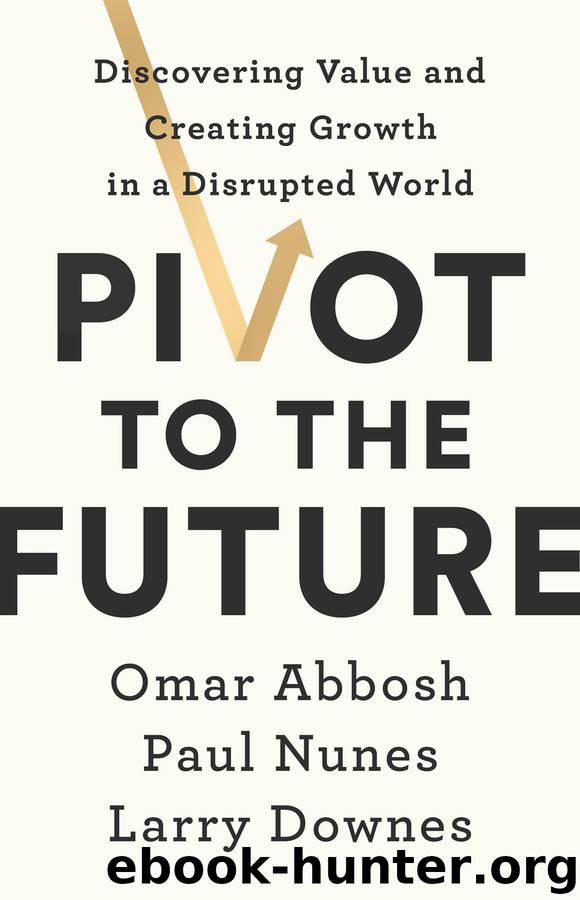Pivot to the Future by Omar Abbosh & Paul Nunes & Larry Downes

Author:Omar Abbosh & Paul Nunes & Larry Downes
Language: eng
Format: epub
Publisher: PublicAffairs
Published: 2019-04-02T04:00:00+00:00
THE NOW: SHOOT FOR THE STARS
The first of our new pivot wisdoms looks at ways to release hidden value in aging products that competitors might already treat as liabilities, searching for an exit. The second looks at the now part of your portfolio: products and services selling well today, but whose underlying technology, while still on a growth trajectory, may soon approach the flattening out of its S-curve.
But that assumes the shape of the curve can’t be altered, an assumption regularly upended by new entrants who destabilize mature markets using new technology. But when incumbents try to respond, they’re frequently met with poor customer reaction. Even though incumbents often apply the same digital components and target the same sources of trapped value as the start-ups, they invariably find themselves outmaneuvered at each pivot.
There’s nothing particularly proprietary in the technology used in an e-commerce website, for example, yet traditional retailers, as we saw in chapter 1, largely foundered in efforts to beat Amazon at its own game. Cloud-supported video and music-streaming, apps, and mobile networks, likewise, are by now completely unremarkable, yet online offerings from incumbent music- and video-content producers had little impact on the rapid consumer adoption of new entrants such as Spotify and Amazon Prime Video.
And while Comcast and other content and distribution leaders are making inroads in streaming media, there’s little question they are chasing Netflix and others, even in the creation of original content. Yet that is the incumbents’ core skill, one honed by decades of Hollywood evolution and technology advances.
So why are so few incumbents winning in the new?
Our research suggests the answer has to do with how companies manage the now. Rather than leveraging today’s core assets to accelerate and scale their entry into new markets, too many incumbents treat those assets like cash cows, milking them for revenue and little else.
Value releasers, on the other hand, embrace a different metaphor. Rather than look at their most profitable products, services, and technologies as an aging set of assets with a fixed value and life span, they see today’s core as a living business that can grow even faster by applying the optimal fuel for continued innovation and investment. Rather than accept the shape of the traditional S-curve, they redraw it, turning cows into stars that shine even brighter, expanding at a faster pace and steeper trajectory than before.
“Cash cows,” as the name implies, are products and businesses that can be left to operate largely independently, relied on for dependable profits with little to no reinvestment or innovation. Examples include everything from popular brands of toothpaste, cereals, and sodas to life insurance and tax services. Generating predictable revenue, cash cows can help finance new systems, plants, and acquisitions, and can take up the slack for weaker or still-growing businesses during times of economic downturn.
So it’s perhaps not surprising that today’s executives were taught to milk their cash cows, deriving as much revenue from them today as possible, with little regard for their long-term health.
The expression comes
Download
This site does not store any files on its server. We only index and link to content provided by other sites. Please contact the content providers to delete copyright contents if any and email us, we'll remove relevant links or contents immediately.
Hit Refresh by Satya Nadella(9083)
The Compound Effect by Darren Hardy(8872)
Change Your Questions, Change Your Life by Marilee Adams(7686)
Nudge - Improving Decisions about Health, Wealth, and Happiness by Thaler Sunstein(7659)
The Black Swan by Nassim Nicholas Taleb(7058)
Deep Work by Cal Newport(6966)
Rich Dad Poor Dad by Robert T. Kiyosaki(6514)
Daring Greatly by Brene Brown(6474)
Principles: Life and Work by Ray Dalio(6296)
Playing to Win_ How Strategy Really Works by A.G. Lafley & Roger L. Martin(6084)
Man-made Catastrophes and Risk Information Concealment by Dmitry Chernov & Didier Sornette(5957)
Digital Minimalism by Cal Newport;(5704)
Big Magic: Creative Living Beyond Fear by Elizabeth Gilbert(5679)
The Myth of the Strong Leader by Archie Brown(5458)
The Slight Edge by Jeff Olson(5376)
Discipline Equals Freedom by Jocko Willink(5336)
The Motivation Myth by Jeff Haden(5175)
The Laws of Human Nature by Robert Greene(5081)
Stone's Rules by Roger Stone(5052)
